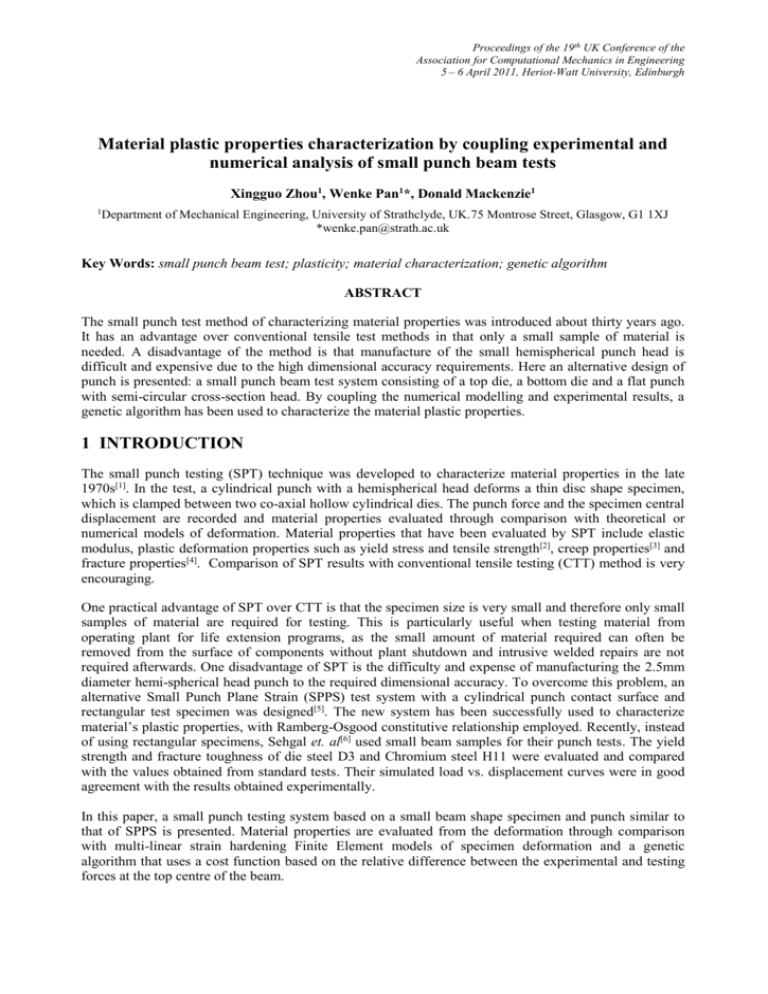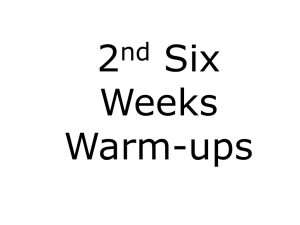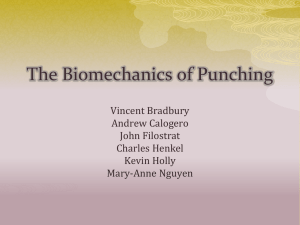Pan W Pure Material plastic properties characterization by coupling
advertisement

Proceedings of the 19th UK Conference of the Association for Computational Mechanics in Engineering 5 – 6 April 2011, Heriot-Watt University, Edinburgh Material plastic properties characterization by coupling experimental and numerical analysis of small punch beam tests Xingguo Zhou1, Wenke Pan1*, Donald Mackenzie1 1 Department of Mechanical Engineering, University of Strathclyde, UK.75 Montrose Street, Glasgow, G1 1XJ *wenke.pan@strath.ac.uk Key Words: small punch beam test; plasticity; material characterization; genetic algorithm ABSTRACT The small punch test method of characterizing material properties was introduced about thirty years ago. It has an advantage over conventional tensile test methods in that only a small sample of material is needed. A disadvantage of the method is that manufacture of the small hemispherical punch head is difficult and expensive due to the high dimensional accuracy requirements. Here an alternative design of punch is presented: a small punch beam test system consisting of a top die, a bottom die and a flat punch with semi-circular cross-section head. By coupling the numerical modelling and experimental results, a genetic algorithm has been used to characterize the material plastic properties. 1 INTRODUCTION The small punch testing (SPT) technique was developed to characterize material properties in the late 1970s[1]. In the test, a cylindrical punch with a hemispherical head deforms a thin disc shape specimen, which is clamped between two co-axial hollow cylindrical dies. The punch force and the specimen central displacement are recorded and material properties evaluated through comparison with theoretical or numerical models of deformation. Material properties that have been evaluated by SPT include elastic modulus, plastic deformation properties such as yield stress and tensile strength[2], creep properties[3] and fracture properties[4]. Comparison of SPT results with conventional tensile testing (CTT) method is very encouraging. One practical advantage of SPT over CTT is that the specimen size is very small and therefore only small samples of material are required for testing. This is particularly useful when testing material from operating plant for life extension programs, as the small amount of material required can often be removed from the surface of components without plant shutdown and intrusive welded repairs are not required afterwards. One disadvantage of SPT is the difficulty and expense of manufacturing the 2.5mm diameter hemi-spherical head punch to the required dimensional accuracy. To overcome this problem, an alternative Small Punch Plane Strain (SPPS) test system with a cylindrical punch contact surface and rectangular test specimen was designed[5]. The new system has been successfully used to characterize material’s plastic properties, with Ramberg-Osgood constitutive relationship employed. Recently, instead of using rectangular specimens, Sehgal et. al[6] used small beam samples for their punch tests. The yield strength and fracture toughness of die steel D3 and Chromium steel H11 were evaluated and compared with the values obtained from standard tests. Their simulated load vs. displacement curves were in good agreement with the results obtained experimentally. In this paper, a small punch testing system based on a small beam shape specimen and punch similar to that of SPPS is presented. Material properties are evaluated from the deformation through comparison with multi-linear strain hardening Finite Element models of specimen deformation and a genetic algorithm that uses a cost function based on the relative difference between the experimental and testing forces at the top centre of the beam. 2 SMALL PUNCH BEAM TESTING TOOL DESIGN The small punch beam testing tool system is shown in Figure 1. Similar to conventional small punch test, this tool system includes a punch, a top die and a bottom die. Instead of thin disc shape sample, a beam with rectangle cross-section shape is used. The hollow cylindrical top and bottom dies of the conventional SPT are replaced by top and bottom blocks, each with a narrow through slot. A shallow slot with depth of 1.5mm and width of 2mm is designed for the test beam specimen to sit in. The punch is a rectangular bar with a half-cylinder profile contact surface, overcoming manufacturing difficulties associated with a hemispherical punch. The radius of the punch head is 1.25mm and the width of the punch is 8mm. To ensure the specimen is held tightly during the testing, the depth of the slot is 0.2mm less than the height of the beam, therefore sufficient clamping pressure will be applied to the ends of the beam to prevent slip when tightening the screws connecting the top and bottom blocks. 3 FEM NUMERICAL MODELLING Figure 2 shows a typical three dimensional ABAQUS/implicit finite element model, which consists of punch, top and bottom die and beam specimen. The specimen is Aluminum and the punch high strength steel, which is much stronger than the specimen. The simulation is therefore simplified by assuming the punch to be a rigid body. The dies are modeled using ABAQUS three dimensional 8-node brick element with reduced integration, assuming a linear elastic material. The specimen is modeled using the higher order C3D20R because of the large deformation of the specimen at the centre and near the die shoulder areas. Friction between punch and specimen, specimen and top die and specimen and bottom die is modeled, assuming a friction factor of 0.3. Both top and bottom die surfaces are constrained with no movement allowed along the loading direction. A reference point is defined for the rigid punch and all degrees of freedom of the reference point are constrained apart from the displacement control in the loading direction. No distinct yield point is observed in stress-strain curves of this type of Aluminum alloy, therefore, the yield stress is defined as the stress corresponding to 0.2% plastic strain. A multi-linear strain hardening material model, as shown in Figure 3, is assumed for analysis. There are three material hardening parameters S1, S2 and S3 to be identified, where S1 and S2 representing stress at the beginning of yield and plastic strain of 0.2%, while S3 representing the ultimate tensile strength. Both material and geometrical nonlinearity are considered in the simulation. 4 GENETIC ALGORITHM A Genetic Algorithm (GA) method is applied to characterize the material nonlinear parameters. The flow chart of a general GA optimization procedure is given in Figure 4. Equation 1 shows the formulation of the objective function Φ, which is defined as the square root of the average of the summation of the square of the relative difference between the experimental and numerical results. The fitness is simply chosen as the inverse of the objective function, i.e. f 1 n Fi cal Fi exp n i 1 Fi exp 1 . 2 Equ.1 Smaller values of the objective function correspond to the larger values of the fitness. The general GA procedure consists of selection, crossover and mutation, with a higher fitness seed having more chance to be selected and one of the fittest off-spring at each generation always being kept. The GA procedure stops when the convergence criterion is satisfied. 5 RESULTS The cross-head speed of the press machine used for the test is very slow and the problem is treated as a static problem. Mesh convergence was investigated first, with three cases having different mesh sizes being studied. The results from the finest mesh are used for all the data analysis as the relative error of the calculated displacement at the central point on bottom surface is less than 1.5% if compared with the coarser mesh having roughly twice the mesh size of the finest mesh. Force, N Displacement, mm After 20 generations of GA evolution, the best value of the objective function is 6.5%. The values of the material parameters S1, S2 and Figure 5 Comparison between the numerically S3 are 102.2MPa, 219.9MPa and 509MPa predicted force vs beam top surface central respectively. Figure 5 shows the comparison displacement and experimentally obtained curve between the numerically predicted force versus beam top surface central displacement and that of experimentally obtained force. From this figure, it can be seen that the numerical results are in good agreement with that of experimental results. Due to the fluctuation of the experimental results, it is difficult to obtain better results after 20 iterations. The tested Aluminium has no obvious yield point, but the ultimate tensile stress identified from this GA procedure is very close to 483MPa (relative error is 5%) obtained through conventional tensile testing. 6 CONCLUSIONS AND FUTURE WORK A small punch beam testing system has been designed and GA method coupled with experimental and numerical results to characterize the material plastic properties. The relative error between the predicted ultimate tensile strength and those obtained by conventional tensile testing method is about 5%. The advantages of this method include the lower cost of manufacturing of the punch, the smaller volume of material required for testing and the GA method predicts the material properties automatically. Future work will be extension of this method to material damage parameters and fracture toughness identification. References [1] Manahan, M.P, Argon, A.S., and Harling O.K., J. of Nuclear Materials, 103&104, North-Holland Publishing Company, 1981, PP. 1545-1550. [2] Abendroth, M. and Kuna, M., Computational Materials Science, 28(2003), pp633-644. [3] Xiang Ling, Yangyan Zheng, Yingjun You and Yuxin Chen, International Journal of Pressure Vessels and Piping, Volume 84, Issue 5, May 2007, Pages 304-309 [4] Mao, X., Takahashi, H., J. of Nuclear Material, 1987, vol. 150, North Holland Publi. Co., pp44-52. [5] W. Pan, Jim Boyle, Mohd. Ramlan, Craig Dun, Mohd. Ismail, Kenji Hakoda, selected for Czech Metallurgical Journal, Vol. LXIII, 2010, pp.174-179. [6] Sehgal, D.K. Husain, A. and Pandey, R.K., Mechanical and Electronics Engineering (ICMEE), 2010, 2nd International Conference, Vol.1, V1-196-V1-199, Kyoto, ISBN: 978-1-4244-7479-0. Punch Top die Bottom die Figure 2 Finite element model Stress, MPa S3 S2 S1 Strain Figure 3 Multi-linear stress strain curve with parameters S1, S2 and S3 to be identified Start Input upper and lower limits for S1,S2, S3 and the population size Initialization: random seeds (S1,S2,S3) for 1st generation GA process via selection, crossover and mutation to obtain next generation ABAQUS numerical modelling for different cases no yes End f f0 Figure 4 Flow chart of the genetic algorithm Output F-U data & calculating the value of objective function and fitness for each seed









